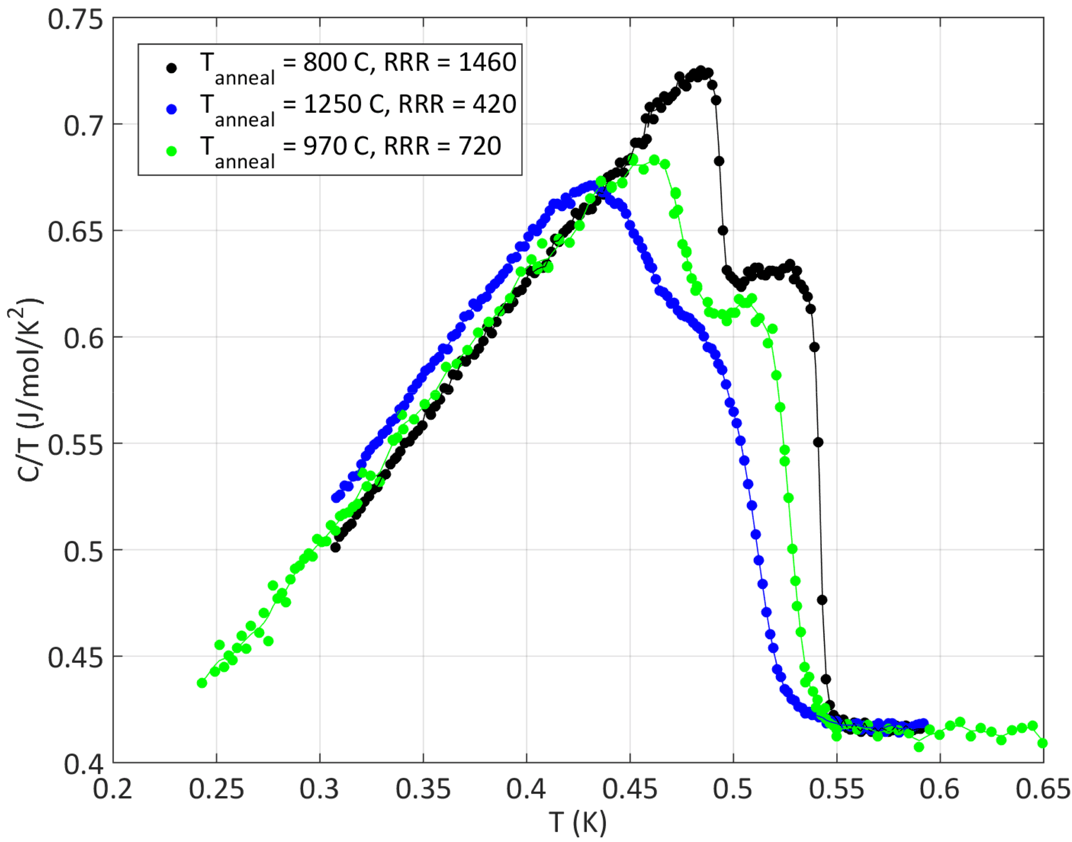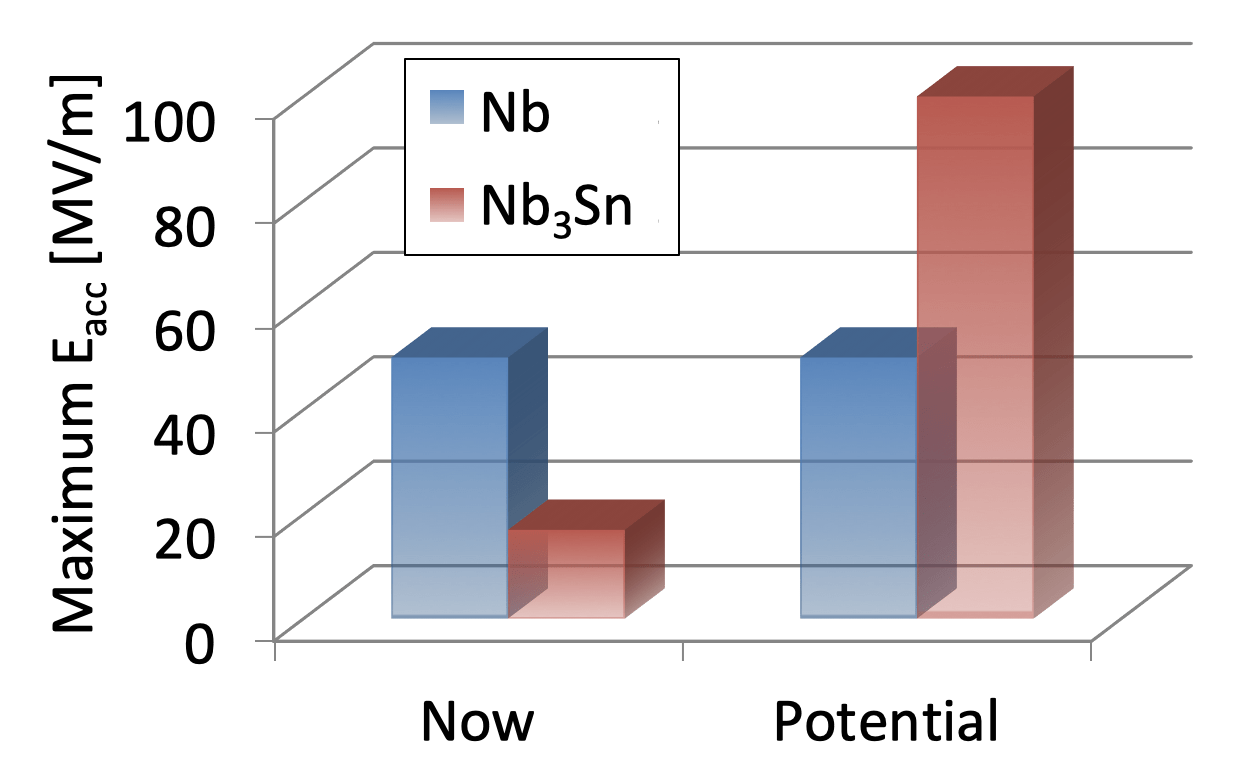Materials for Superconducting RF Cavities
CAPST researchers process, modify and characterize superconducting materials for superconducting radio frequency (SRF) cavities for applications ranging from high energy particle accelerators, operating with intense electromagnetic fields, to single photon detectors for quantum sensing and quantum computing [read more]. For accelerator applications Nitrogen-doped Niobium is the current standard for superconducting radio-frequency cavities, and is the technology employed in state-of-the-art SRF cavities for the LCLS-II accelerator at SLAC, the world’s first hard X-ray free-electron laser [read more]. CAPST research combines first-principles theory of nonequilibrium superconductivity with materials characterization and cavity-based measurements of impurity doped Niobium to understand the physical processes and material properties that limit the performance of SRF cavities. The goal of CAPST research is to push the performance to the theoretical limits the quality factor of SRF cavities, Q, and the accelerating field that can sustained, Eacc [read more].
3D Topological Superconductors
CAPST researchers grow high-quality single crystals of topological superconductors. Single crystals of high temperature cuprate superconductors, heavy fermion superconductors and multi-band superconductors are grown and studied by nuclear magnetic resonance (NMR), small-angle neutron scattering (SANS), as well as electrical and thermal transport studies.
Ultra-pure UPt3 exhibits two zero-field superconducting transitions as shown by the two heat capacity jumps (right panel), i.e. a high temperature A phase with Tc1 = 550 mK and a low temperature B phase with Tc2 = 490 mK for RRR 1460. Optical reflection experiments show a Polar Kerr effect onsetting at Tc2,implying the A phase is time-reversal symmetric, but the B phase breaks both time-reversal and mirror reflection symmetries consistent with theoretical predictions of topological and chiral superconductivity in UPt3. Publication: Broken time-reversal symmetry in the heavy-fermion superconductor UPt3, Science 345, 190 (2014).

Ultra-high vacuum electron beam, float-zone facility for high-purity crystal growth fabrication. Shown here is zone-refining of a single-crystal of the topological superconductor UPt3.
Topological Superconductivity in Sr0.1Bi2Se3
CAPST researchers at Argonne National Lab (W. Kwok, A. Koshelev, U. Welp) reported results supporting a recently proposed odd-parity, nematic superconducting state in doped topological insulators, MxBi2Se3. Angular dependent magneto-transport and magnetization measurements show a pronounced two-fold, in-plane anisotropy of the superconducting state that develops from the trigonal parent state of Sr0.1Bi2Se3, i.e. a normal state with no measureable two-fold anisotropy. The results support the conclusion that the two-fold anisotropy originates from spontaneously broken rotational symmetry by p-wave Cooper pairs. This result implies that Sr0.1Bi2Se3 is a bulk topological superconductor. Publication: Scientific Reports 8, 7666 (2018).
More CAPST research MxBi2Se3: Higgs excitations and electromagnetic response of topological nematic superconductors.
 Left: C3d crystal structure of Bi2Se3. Right: The order parameter amplitude defined on the Fermi surface for the superconducting phase of Sr0.1Bi2Se3. The order parameter exhibits nodes on the mirror plane, with deep minima in the perpendicular direction. This order parameter breaks the threefold crystal symmetry and gives rise to the topological nematic state.
Left: C3d crystal structure of Bi2Se3. Right: The order parameter amplitude defined on the Fermi surface for the superconducting phase of Sr0.1Bi2Se3. The order parameter exhibits nodes on the mirror plane, with deep minima in the perpendicular direction. This order parameter breaks the threefold crystal symmetry and gives rise to the topological nematic state.
Nb3Sn Superconducting RF Cavities
While the current state-of-the-art accelerator technology is based on Niobium SRF cavities, next-generation particle accelerators for high energy physics may require accelerating fields beyond that achievable with Niobium. Superconducting Nb3Sn is leading candidate for next generation accelerator technology. With a transition temperature of 18 K, Nb3Sn promises improved cryogenic efficiency and increased accelerating gradients. CAPST researchers at Fermilab have developed a process to coat Nb with Nb3Sn. Research using facilities at Northwestern and Fermilab on Nb3Sn to understand the materials properties of Nb3Sn and their impact on the performance of Nb3Sn SRF cavities is ongoing. Although not yet competitive with Nitrogen-doped Niobium, Nb3Sn SRF technology has the potential to offer dramatic improvements for large-scale applications in high energy physics, nuclear physics, and basic energy sciences. Publications: Phys. Rev. Lett. 115, 047001 (2015) and Appl. Phys. Lett. 106, 082601 (2015)


